Abstract
The Yangtze Block, with its widespread Neoproterozoic mafic–felsic magmatic rock series and volcanic–sedimentary rock assemblages, is one of the key windows for reconstructing the assembly and fragmentation process of Rodinia. This study focuses on the Taoyuan syenogranite from the Micangshan Massif on the northern Yangtze Block, by conducting systematic chronology, mineralogy, and geochemistry analyses to investigate their source, petrogenesis, and tectonic setting. LA-ICP-MS U–Pb geochronology reveals that the medium- to coarse-grained and medium- to fine-grained syenogranites have crystallization ages of 878 ± 4.2 Ma and 880 ± 6.5 Ma, respectively. These syenogranites have aluminum saturation index (A/CNK) values ranging from 0.79 to 1.06, indicating quasi-aluminous to weakly peraluminous compositions, and are classified as calc-alkaline I-type granites. The geochemical indicators of these rocks, including Mg# (44–48, mean 46), Zr/Hf (40.07), Nb/La (0.4), and zircon εHf(t) values (+9.2 to +10.9), collectively indicate a depleted lithospheric mantle source. The mantle source was metasomatized by subduction-derived fluids and sediment melts prior to partial melting as evidenced by their higher Mg#, elevated Ba content, and distinctive ratios (Rb/Y, Nb/Y, Th/Yb, Th/Sm, Th/Ce, and Ba/La). Integrating regional data, this study confirms crust–mantle interaction along the northern Yangtze during the early Neoproterozoic, supporting a sustained subduction-related tectonic setting.
1. Introduction
As one of the core components of the Rodinia supercontinent, the Yangtze Block provides a critical geological window for understanding the dynamic processes of Rodinia’s assembly and breakup. The widespread Neoproterozoic mafic–felsic magmatic rock series and volcanic–sedimentary rock assemblages in this block comprehensively record the coupling relationship between deep tectonic processes and shallow geological responses during this period, making it an important carrier for deciphering the Neoproterozoic evolution history and dynamic mechanism of the Yangtze Block [1,2,3,4,5,6,7,8,9].
Regarding the Neoproterozoic dynamic mechanism of the Yangtze Block, three major academic disagreements currently exist: (1) Mantle plume rift model: Proposes that the Yangtze and Cathaysia Blocks had already coalesced during the Grenville orogeny (~1.1–1.0 Ga), with the entire region being in an intracontinental rift environment between 860 and 750 Ma [1,2,3,10]; (2) Plate subduction model: Argues that the western margin of the Yangtze Block evolved as an Andean-type active continental margin between 860 and 720 Ma, while its southeastern margin and the Cathaysia Block underwent convergence and accretion as late as 820 Ma [4,6,7,8,11,12,13]; (3) Plate rift model: Suggests that after 860 Ma, the Yangtze Block entered a post-orogenic collapse phase, entirely under an extensional tectonic setting [14,15].
The Micangshan Massif, located on the northern Yangtze Block, is a key area for understanding the tectonic evolution of the Yangtze Block (Figure 1). Recent breakthroughs in geochronology and geochemistry have made the tectonic magmatic evolution history of the Micangshan Block increasingly clear. Regarding the tectonic setting prior to 860 Ma, the only exception is the ijolites from the Pinghe area, which have been interpreted as evidence for an intracontinental rift setting [16]. Most rock assemblages exhibit island arc affinities, which are indicative of a subduction-related environment. These include the mafic rocks in the Hekou area, ijolites and urtites in the Pinghe area, cumulate gabbros in the Beibei area, and syenites in the Shuimo area [17,18]. Petrogenetic studies attribute these rocks to the partial melting of juvenile lower crust [17] or the mantle [17,19]. However, the role of mantle-derived magmatism—particularly its interaction with subduction-derived slab fluids and sediment melts—remains poorly constrained and warrants further investigation.
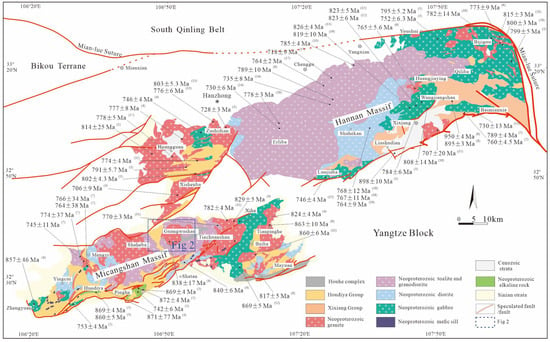
Figure 1.
Simplified geological map of the Hannan and Micangshan Massifs in the Northern Yangtze Block, South China (after [4,20]). (1) Ao, 2015 [21]; (2) Deng et al., 2013 [22]; (3) Dong et al., 2011 [13]; (4) Dong et al., 2012 [4]; (5) Gan, 2015 [23]; (6) Geng et al., 2010 [24]; (7) Li, 2010 [25]; (8) Ling et al., 2003 [26]; (9) Ling et al., 2009 [27]; (10) Liu et al., 2009 [28]; (11) Luo et al., 2018 [17]; (12) Wang et al., 2016 [29]; (13) Xia et al., 2009 [30]; (14) Zhao and zhou, 2008 [31]; (15) Zhao and Zhou, 2009a [32]; (16) Zhao and Zhou, 2009b [33]; (17) Zhao et al., 2006 [34]; (18) Zhao et al., 2010 [35]; (19) Zhou et al., 2002 [36]; (20) Zhu et al., 2018 [37].
Therefore, this paper selects the syenogranite from the Taoyuan pluton on the northern margin of the Yangtze Block as the research object. Systematic field geology, petrology, zircon U–Pb geochronology, and geochemical studies have been conducted to precisely determine the formation age, material source, and genesis of the related magmatic rocks. By synthesizing regional geological data, this study aims to evaluate the role of slab-derived fluids and sediment melts in modifying mantle sources during Neoproterozoic subduction processes.
2. Geological Background
Due to the development of a large number of rocks related to the Neoproterozoic orogenic belt, the Yangtze Block is listed as part of Rodinia [10,15]. The Yangtze Block is structurally bounded by: (1) the Qinling–Dabie–Sulu high- to ultrahigh-pressure metamorphic belt to the north, which separates it from the North China Block; (2) the Longmenshan Fault Zone to the west, marking its boundary with the Tibetan Plateau; (3) the Jiangnan orogenic belt to the southeast, forming the tectonic contact with the Cathaysia Block [38]. The crustal structure of the Yangtze Block exhibits distinct vertical stratification: (1) a lower layer consisting of Neoarchean to Paleoproterozoic highly metamorphosed crystalline basement, (2) a middle layer comprising Meso- to Neo-proterozoic greenschist facies-metamorphosed transitional basement, (3) an upper layer of unmetamorphosed Sinian to Mesozoic clastic and carbonate sedimentary cover [4].
The Micangshan tectonic belt is located on the northern Yangtze Block, at the junction of the Yangtze River drainage area, the South Qinling orogenic belt, and the northeastern Tibetan Plateau (Figure 1). The regional stratigraphy can be divided into three major structural layers. The crystalline basement (Houhe Group) comprises two principal lithological assemblages: (1) ~2.08 Ga high-grade metamorphic rocks including gneisses, migmatites, and metabasalts [39], (2) ~1.77 Ga intrusive suites dominated by K-feldspar granites and A-type granites [40,41]. The fold basement, represented by the Meso- to Neo-proterozoic Huodiya Group, unconformably overlies the crystalline basement and comprises three distinct lithostratigraphic units: (1) the Shangliang Formation, characterized by slate-dominated sequences with minor schist and siliceous intercalations, yielding a maximum depositional age of 837.6 ± 6.0 Ma [42]; (2) the Mawozi Formation, consisting predominantly of dolomitic carbonate deposits; (3) the Tiechuanshan Formation, composed mainly of metamorphosed volcaniclastic rocks, with interbedded rhyolite dated at 817.5 ± 5.0 Ma [26]. The sedimentary cover succession comprises a predominantly shallow marine sequence spanning from the Sinian to Middle Jurassic, characterized by alternating clastic and carbonate deposits with intermittent volcanic intercalations. This succession includes well-developed Sinian, Silurian–Permian, and Late Triassic–Middle Jurassic strata, while exhibiting a notable depositional hiatus marked by the absence of Devonian–Carboniferous units.
The Micangshan region records multiple Neoproterozoic magmatic intrusive events (Figure 1), which can be categorized geochemically into: subduction-related magmatism represented by alkaline rocks in the Pinghe pluton (872–860 Ma [19]); granitoids in the Tianpinghe pluton (863–860 Ma [17,27]); Guangwushan syenogranite (836–838 Ma [4,43]); intermediate–mafic rocks in the Beibei pluton (diorite, 869 Ma; gabbro, 814 Ma [17,29]); the Xihe gabbro–granite suite (829–824 Ma [4]); volcanic units comprising Xishenba granite (887 Ma [44]) and Shuimo syenite (869–860 Ma); metamorphic felsic rocks and amphibolites in the Hekoutou area (867–858 Ma); and Wangjiaping gneissic volcanic rocks (863–866 Ma) [18]. Back-arc extension-related magmatism includes the Tiechuanshan and Huangguan A-type granites and Taojiaba granodiorite [18]. Post-collisional magmatism is evidenced by the Xishenba monzogranite (706 Ma [4]). Continental rift-related magmatism comprises the Menzixiang quartz diorite–gabbro–norite–granite suite (774–745 Ma [45]).
3. Petrography
The study materials comprise two geochronological samples and nine geochemical samples collected from the Taoyuan pluton, adjacent to the northeast side of the Guangwushan pluton (Figure 2). The Taoyuan pluton shows distinct contact relationships: its northwestern margin is unconformably overlain by the Huodiya Group, while the southeastern portion is intruded by the Guangwushan granite (Figure 2).
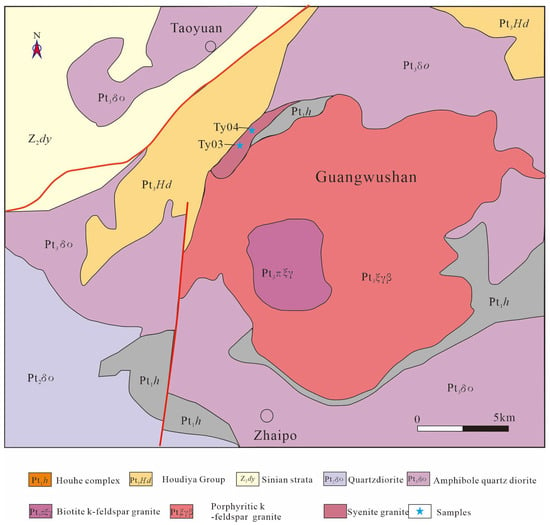
Figure 2.
Simplified geological map and sampling position of the Guangwushan area in the Micangshan Massif [43].
Field observations reveal that the rocks generally exhibit a massive structure with relatively homogeneous petrographic features, though minor variations in quartz and plagioclase content, grain size, and biotite occurrence were noted. The dominant lithology is syenogranite, characterized by grayish-white to light gray fresh surfaces and a cataclastic texture (Figure 3a,b). Petrographic analysis reveals distinct mineralogical compositions between the two samples: Ty03 exhibits a modal composition of 46% potassium feldspar (dominant), 28% plagioclase, 22% quartz, and 4% muscovite; Ty04 shows a similar assemblage with 42% potassium feldspar, 30% plagioclase, 25% quartz, and 3% muscovite. Both samples contain accessory minerals including apatite, rhodochrosite, and opaque metallic minerals. Petrographic observations under a microscope (Figure 3c,d) show that (1) K-feldspars occur as perthite and microcline with anhedral tabular shapes, displaying typical gridiron twinning and strong argillic alteration, with occasional myrmekitic textures; (2) plagioclases show subhedral to anhedral tabular forms with well-developed polysynthetic twinning, exhibiting intensive sericitization and clay alteration; (3) quartz appears as anhedral grains with intracrystalline fractures and occasional undulose extinction; (4) muscovite occurs as anhedral flakes showing weak pleochroism and bright interference colors, occasionally containing accessory mineral inclusions such as apatite and zircon.
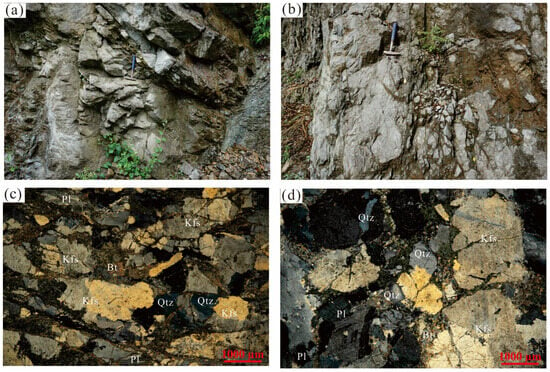
Figure 3.
Field photographs (a,b) and photomicrographs (c,d) of the Taoyuan syenogranite. (a,c) come from Ty03; (b,d) come from Ty04. Mineral abbreviations: Bt = biotite, Qtz = quartz, Pl = plagioclase, Kfs = K-feldspar.
4. Analytical Methods
Zircon separation, mounting, and cathodoluminescence (CL) imaging were performed at Langfang Yantuo Geological Service Co., Ltd. (Langfang, China). Zircon U–Pb dating and Hf isotope analysis were conducted at Wuhan SampleSolution Analytical Technology Co., Ltd. (Wuhan, China).
Zircon U–Pb dating was performed using Laser Ablation Inductively Coupled Plasma Mass Spectrometry (LA-ICP-MS). The detailed instrument parameters and analytical procedures are described in Zong et al. (2017) [46]. The laser ablation system consisted of a GeolasPro equipped with a MicroLas optical system (incorporating a COMPexPro 102 ArF 193 nm excimer laser) Coherent Corp., Saxonburg, PA, USA, coupled to an Agilent 7700e ICP-MS instrument (Quadrupole Mass Spectrometer) Agilent Technologies, Santa Clara, CA, USA. Analyses employed a laser beam diameter of 32 µm and a repetition rate of 5 Hz. Analyses were performed in groups of ten spots, using standard zircon 91500 as the U–Pb external standard, NIST 610 as the composition standard, and 29Si as the internal standard element [47,48]. Data processing was carried out using the ICPMSDataCal 10.9 software [49]. Zircon U–Pb concordia diagram plotting and weighted mean age calculations were performed using the Isoplot/Ex_ver. 3 software [50].
Zircon Hf isotope analysis was similarly conducted using a 193 nm ArF excimer laser ablation system (Geolas HD, Coherent, Dieburg, Germany) coupled to a Multi-Collector Inductively Coupled Plasma Mass Spectrometer (MC-ICP-MS, Neptune Plus, Thermo Fisher Scientific, Bremen, Germany). The detailed analytical procedures and methods are provided in Hu et al. (2015) [51]. Analytical parameters included a laser spot size of 44 μm and an energy density output of ~7.0 J/cm2. Isobaric interference corrections for 176Lu and 176Yb on 176Hf were applied using 176Lu/175Lu = 0.02669 and 176Yb/172Yb = 0.5886. Standard zircons 91500, GJ-1, and SP-01 were used to monitor data quality during the analyses. Data processing, including the selection of sample and blank signals and mass bias correction for isotope ratios, was performed using the ICPMSDataCal 10.9 software [49].
Whole-rock major and trace element analysis samples were fresh rock powders ground to less than 200-mesh using an agate ball mill. Analyses were performed at Wuhan Shangpu Analytical Technology Co., Ltd. (Wuhan, China). Major elements were determined using a Rigaku Primus II X-ray Fluorescence Spectrometer (XRF, Rigaku Corporation, Tokyo, Japan), and trace elements were analyzed using an Agilent 7700e ICP-MS Agilent Technologies, Santa Clara, CA, USA. The detailed testing procedures are described in Liu et al. (2008) [52]. Data quality was monitored through replicate analyses, international rock standard AGV-2, and national rock standards GSR-1 and GRS-7, with analytical precision better than 4% and accuracy better than 3%.
5. Results
5.1. LA-ICP-MS Zircon U–Pb Geochronology
Two representative granite samples (Ty03 and Ty04) from the Taoyuan pluton were selected for zircon U–Pb geochronology. The analytical results are provided in Table S1, with representative cathodoluminescence (CL) images and concordia diagrams shown in Figure 4 and Figure 5, respectively. The zircons from both samples were predominantly euhedral to subhedral prismatic crystals, with aspect ratios of ~1:1 to 4:1. CL imaging reveals oscillatory zoning and lengths of 80–250 μm (Figure 4), consistent with a magmatic origin. In sample Ty03, 10 reliable analysis points have varying Th (76.8–247 ppm) and U (114–336 ppm) contents, as well as Th/U (0.69–0.93) ratios. These 10 harmonic analysis points show that the age distribution of 206Pb/238U ranges from 866 ± 9.4 Ma to 903 ± 8.1 Ma, and the weighted average age of the obtained harmonic zircons is 878.8 ± 4.2 Ma (MSWD = 2.4 n = 10) (Figure 5a,b). For sample Ty04, 16 reliable analysis points have low Th (58.4–322 ppm) and U (83.8–452 ppm) content, as well as Th/U (0.55–0.96) ratios. These 16 analysis points obtained a harmonic weighted average age of 880 ± 6.5 Ma (MSWD = 2.7, n = 16) (Figure 5c,d). The consistent ages (~880 Ma) from both samples constrain the emplacement age of the Taoyuan pluton to the late Neoproterozoic (Tonian), correlating with regional magmatic events in the Micangshan Massif.
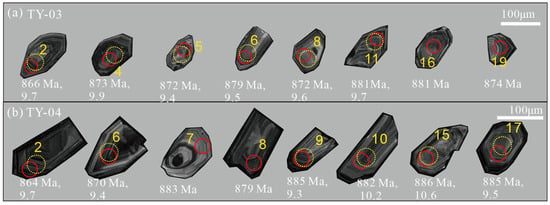
Figure 4.
Cathodoluminescence images of zircons in samplesTy03 (a) and Ty04 (b) of Taoyuan syenogranite. Red solid circles show the U–Pb spots; and yellow dashed circles represent the Hf isotope spots. The age shown is 207Pb/206Pb apparent age. The number is Hf value.
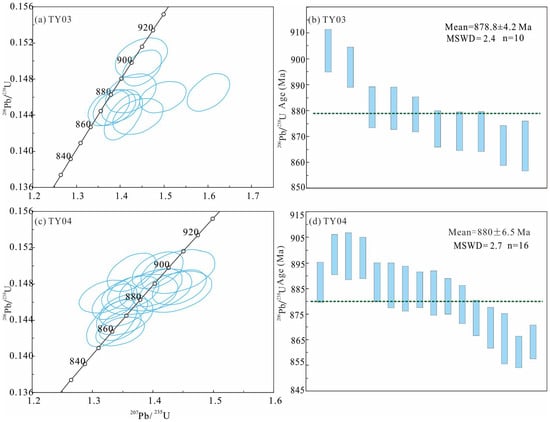
Figure 5.
U–Pb concordia plots for Ty03 (a,b) and Ty04 (c,d) of the Taoyuan syenogranite. Data from Table S1.
5.2. Hf Isotope Characteristics
During zircon U–Pb dating, 27 zircons were selected for in situ Lu–Hf isotope analysis. These zircons were co-located with the sites where U–Pb age determinations had been previously conducted, though the latter exhibited a broader age distribution (Figure 4). The measured 176Lu/177Hf ratios of zircons from the Jiangnan granite samples were predominantly below 0.002 (Table S2), suggesting minimal post-crystallization radiogenic Hf accumulation. Consequently, the initial 176Hf/177Hf ratios remained well preserved [53]. For the calculation of initial εHf(t) values and model ages (TDM2), the crystallization age of the syenogranite was applied as the correction reference. The results showed that the 176Hf/177 Hf at 27 test points ranged from 0.282507 to 0.282555, and the initial Hf isotope ratio εHf (t) was 8.8–10.9, with an average of 9.82. The TDM2 value was 1093–1159 Ma. On the ε Hf (t)–t diagram, all test points were located between the depleted mantle and the chondrite evolution line.
5.3. Geochemistry of Major Trace Elements in Whole Rocks
Samples Ty03 and Ty04 are characterized by a high SiO2 content (63.29–68.73 wt.%), low K2O content (0.94–2.19 wt.%), and elevated Na2O content (5.63–7.34 wt.%). These samples exhibit a moderate Al2O3 content (15.51–16.57wt.%) and A/CNK ratios (molar Al2O3/(CaO + Na2O + K2O) = 0.79–1.06) indicative of quasi-aluminous characteristics and being part of the medium-potassium calc-alkaline series (Figure 6a,b). Additionally, they display a high MgO content (1.16–1.72 wt.%) and Mg# values (44–48, mean = 46), consistent with high-magnesium syenogranite. Notably, these samples are enriched in CaO (1.19–3.97 wt.%) and Fe2O3T (2.72–4.11 wt.%).
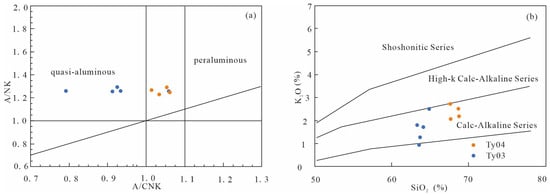
Figure 6.
A/NK–A/CNK (a) and K2O–SiO2 identification diagram of Taoyuan syenogranite (a) after Maniar and Piccoli, 1989 [54]; (b) after Rollinson, 1993 [55], showing quasi-aluminous to weakly peraluminous compositions, and calc-alkaline series.
In the chondrite-normalized rare earth element (REE) diagram (Figure 7a), the Taoyuan syenogranite exhibits a total REE content (∑REE) of 99.1–120.5 ppm, with a coherent REE distribution pattern: slight enrichment in LREEs (La/Yb)N= 7.57–11.01); and relatively flat heavy rare earth elements (HREEs); alongside negligible Eu anomalies (Eu/Eu* = 0.80–0.98) (Figure 7b). On the primitive mantle-normalized trace element spider diagram (Figure 5b), the Taoyuan syenogranite demonstrates an enrichment in LILEs (e.g., Ba and K) and a depletion in HFSEs (e.g., Nb, Ta, Th, and U).
Furthermore, distinct from the typical trace element signatures of adakites [56,57,58,59,60,61], the Taoyuan syenogranite aligns with the normal andesite–dacite–rhyolite series, exhibiting variable Sr (116–349 ppm) and Y (11.4–14.1 ppm) concentrations, as well as Sr/Y ratios (8.32–30.51). These rocks also contain lower abundances of compatible elements (e.g., Cr = 8.64–14.33 ppm; Ni = 7.61–11.36 ppm).
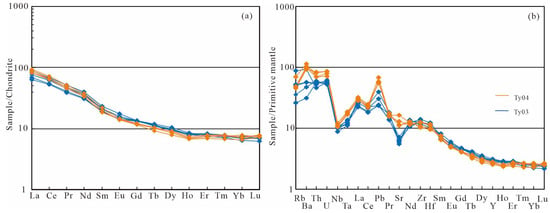
Figure 7.
Chondrite-normalized REE patterns (a) and primitive mantle-normalized trace element spidergram (b) for the Taoyuan syenogranite. The chondrite and primitive mantle data are from Sun and McDonough (1989) [62]. Data sources are in Table S3.
6. Discussion
6.1. Classification
According to the source rock properties of granite, it is traditionally classified into three types: Type I, Type S, and Type A. The syenogranite exhibits distinct non-A-type granite characteristics, as evidenced by the following: (1) In the thin sections, no characteristic alkaline dark minerals such as sodium amphibole, iron amphibole, aegirine pyroxene, and iron olivine were observed, which is significantly different from A-type granite [63]. (2) The sample has the characteristics of low total alkali mass fraction (mean 8.33%) and low TFeO/MgO (mean 2.11), which is significantly different from the high total alkali (>8.5%) and high TFeO/MgO values (>10) of A-type granite [64,65]. (3) Taoyuan syenogranite exhibits relatively low concentrations of Ga and high-field-strength elements (HFSEs), including Zr, Nb, and Ta, which contrasts sharply with the enrichment patterns typical of A-type granites [66,67]. (4) The saturation temperature of whole rock zircon is 726–767 °C, which is significantly lower than the average temperature of A-type granite at 833 °C [68]. (5) In the classification map of granite rock types, all samples of granodiorite porphyry are located in non-A-type granite areas (Figure 8; [64]).
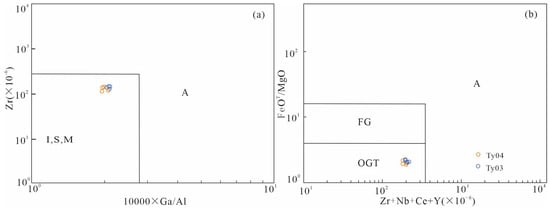
Figure 8.
Diagrams of 10000 × Ga/Al-Nb (a) and (Zr + Nb + Ce + Y)–TFeO/MgO (b), showing that the Taoyuan syenogranite belongs to I-type granite (a,b after [64]).
In addition, the geochemical characteristics of Taoyuan syenogranite exclude the possibility of S-type granite: it has a lower A/CNK value (0.79~1.06 < 1.10) and the P2O5 content (0.07%~0. 12% < 0.20%) obviously does not conform to the characteristic of S-type granite of a strong aluminum content [63]. Syenogranite has a high Na2O content (>5.6%), which is completely different from the typical S-type granite characteristics [69]. In addition, in mineralogy, only a small amount of muscovite is observed, and no aluminum-rich minerals such as corundum, tourmaline, cordierite, garnet, etc., are found, which is significantly different from typical S-type granite (such as [70]).
Instead, the Taoyuan syenogranite exhibits geochemical signatures consistent with I-type granites. It is characterized by high Na2O and CaO contents and a metaluminous to weakly peraluminous composition which is consistent with typical Type I granite [71]. In the Harker diagram, there is a negative correlation between SiO2 and P2O5 (Figure 10f), which is consistent with the evolution trend of type I granite [63].
6.2. Source Nature
The determination of magma source characteristics is crucial for understanding magmatic rock petrogenesis and tectonic settings. The syenogranite exhibits an average Rb/Sr ratio of 0.19, approximating the continental crustal average (0.24) and markedly exceeding the upper mantle value (0.025). The mean Nb/Ta ratio (12.68) is intermediate between mantle-derived rocks (17.5 ± 2 [72,73]) and continental crust (~11; [73,74]). Zr/Hf ratios (38.86–41.69, mean = 40.07) significantly surpass typical crustal values (~33; [73,74]). These systematic geochemical variations demonstrate that the syenogranite was not generated solely through lower crustal partial melting but involved substantial mantle-derived contributions.
Zircon Hf isotopes provide robust constraints on magma sources due to their high closure temperature and resistance to post-crystallization alteration [75,76]. The εHf(t) values and 176Hf/177Hf ratios plot of the syenogranite is located between the depleted mantle (DM) and chondritic uniform reservoir (CHUR) evolution lines (Figure 9a,b), indicating derivation from either depleted mantle or juvenile crustal sources. However, experimental petrology demonstrates that partial melts from mafic lower crust typically yield low MgO (<3 wt.%) and Mg# (<45) values [77]. In contrast, the syenogranite exhibits elevated MgO (1.16–1.72 wt.%) and Mg# (44–48, mean = 46) values (Figure 9c), which are inconsistent with pure crustal melting but indicative of a mantle source. This interpretation is further supported by high Zr/Sm and Hf/Sm ratios, precluding carbonate metasomatism [78] (Figure 9d), and Nb/La ratios (0.4) matching lithospheric mantle values (0.3–0.4) rather than OIB-type asthenosphere (>1; [79]).
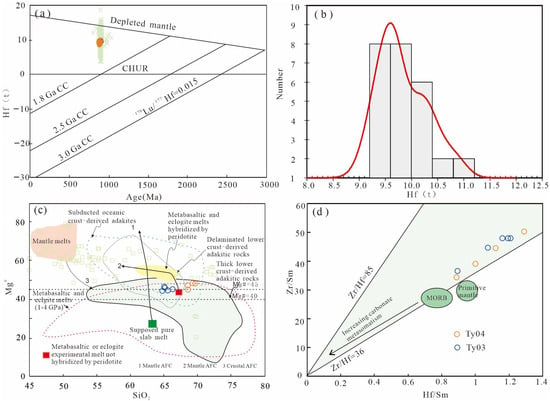
Figure 9.
Plots of Hf(t) vs. age (a), 176Hf/177Hf vs. age (b), Mg# vs. SiO2 (c), and Zr/Sm vs. Hf/Sm (d) for the Taoyuan syenogranite. The green cross data in (a) is derived from Yan et al., 2014 [80]; Xu et al., 2016 [81]; Zhou et al., 2018 [16]; Luo et al., 2018 [17]; Wu et al., 2019 [82], 2023 [83]; Wang et al., 2021 [84]; Huang et al., 2023 [85]. (c) is after DuPuy et al., 1992 [78]. (c) shows fields of metabasaltic and eclogite experimental melts (1.0–4.0 GPa) after Rapp et al. (1999) [86] and references therein. The mantle AFC curves are after Stern and Kilian (1996) [87] (curve 1) and Rapp et al. (1999) (curve 2) [86]. The crustal AFC is after Stern and Kilian (1996) [87] (curve 3). The supposed pure slab melt is from Stern and Kilian (1996) [87]. The metabasaltic or eclogite experimental melt not hybridized by peridotite is from Rapp et al. (1999) [86]. The field of high-Mg diorite suites is after Smithies and Champion (2000) [88]. (c) The green square datas are sourced from the 880 Ma gabbro and diorite in the Bikou Terrane [89]; the 884 Ma Pingtoushan diorite, Guankouya diorite, and Liujiaping gabbro [90]; the 879 Ma Tongchang diorite [91]; the 882–895 Ma ijolite in Pinghe [16]; the 879 Ma cumulate gabbro in Beiba [17]; the 885 Ma hornblende gabbro and diorite in Mihunzhen and Fenghuang [92]; and the ~900–880 Ma Xiaoling diorite and granodiorite [83].
Research indicates that young mantle components primarily participate in the formation of granitic rocks through two mechanisms: one is the mixing of mantle-derived magma and magma induced by the partial melting of crustal material in the deep crust to form crust–mantle mixed-source magma [93,94]. Another type is that mantle magma first invades the crustal bedrock to form the primary crust, and then undergoes partial melting under the influence of later thermal events [95]. Generally, positive εHf(t) values suggest a source derived from juvenile lower crust or depleted mantle [96], while negative εHf(t) values indicate ancient crustal sources. The Hf isotopic values of the Taoyuan syenogranite range from 8.8 to 10.9 (Figure 9a,b), exhibiting homogeneity distinct from the scattered Hf signatures typical of magma mixing. This suggests that the Taoyuan syenogranite did not undergo significant magma mixing. In terms of mineralogy, no magnesian dark inclusions or quenched characteristic mineral needle-shaped apatite were found in the Taoyuan syenogranite, which differs from the mineral characteristics of magma mixing, thus ruling out the magma mixing model.
Collectively, these lines of evidence establish that the Taoyuan syenogranite originated from depleted mantle sources, with its evolved geochemical features attributable to crust–mantle interaction during magma generation and ascent.
6.3. Origin of Taoyuan Syenogranite
6.3.1. Alteration, Crustal Contamination, and Fractional Crystallization
The effectiveness of geochemical data is crucial for determining the source area, genesis, and tectonic background of magmatic rocks. Usually, four geological processes will transform geochemical data, including post-emplacement alteration, crustal contamination, fractional crystallization, and partial melting (e.g., [97,98,99]). The loss on ignition (LOI) values of the syenogranite samples range from 1.54% to 3.73%, suggesting that the samples may have undergone a certain degree of post-magmatic alteration. However, HFSEs such as Th, Ti, Nb, Ta, Zr, Hf, Y, and rare earth elements (REEs) typically remain relatively stable during alteration and weathering processes [100,101]. Zr is commonly used to quantify the mobility of other incompatible elements [102]. In bivariate diagrams, Nb, Ta, Th, and U exhibit significant positive correlations with Zr, and the samples display subparallel REE and multi-element patterns (Figure 7), indicating that these elements were affected minimally by alteration and can thus represent the primary composition [103].
The Taoyuan syenogranites exhibit significant enrichment in LILEs (especially Ba) and LREEs (Table S3), with concentrations exceeding those typical of continental crust [104]. This pronounced enrichment, coupled with their relatively uniform zircon εHf(t) values (9.2–10.6), effectively precludes significant crustal contamination or magma mixing during their formation. Several lines of geochemical evidence support this interpretation: (1) the absence of pronounced positive Zr–Hf anomalies in trace element patterns contradicts the expected signatures of crustal contamination, given the crustal affinity of these elements; (2) elevated Nb/Th (1.2–1.6) and Th/Yb (3.3–5.7) ratios are inconsistent with substantial crustal input; (3) the homogeneous zircon U–Pb ages and lack of ancient inherited zircons further confirm minimal interaction with crustal materials during magma evolution. These collective observations demonstrate that despite their emplacement within the continental crust, the syenogranites preserve primary magmatic signatures that are largely unaffected by crustal contamination processes.
The syenogranite exhibits distinct fractional crystallization trends. In the Harker diagrams (Figure 10a–i), with increasing SiO2 content, the concentrations of CaO, MgO, FeOt, Cr, and Ni decrease while the total alkali content increases, suggesting the possible fractional crystallization of olivine, pyroxene, amphibole and Ti–Fe oxides. During magma differentiation, plagioclase fractionation can produce negative Sr and Eu anomalies, whereas K-feldspar removal leads to negative Eu and Ba anomalies. Although sample Ty03 shows only a slight negative Eu anomaly, both Sr and Ba display varying degrees of negative anomalies (Figure 6), indicating possible feldspar fractionation. In the Ba–Sr diagram, the compositional trend of Ty03 closely follows the K-feldspar fractionation line. The trace element modeling further demonstrates that the combined fractionation of plagioclase and biotite in different proportions can produce similar results (Figure 11a). However, the H2O-rich nature of the primary magma (4% biotite content) may have delayed K-feldspar crystallization [105]. The positive correlation between Ba and SiO2 (Figure 10h) suggests that K-feldspar likely crystallized at later stages. Sample Ty04 may not have experienced significant feldspar fractionation. Although feldspar phenocrysts are present in alkaline rocks (Figure 3c,d), the decreasing Al2O3 with increasing SiO2 (Figure 10a) indicates that plagioclase was not an early fractionating phase. This interpretation is supported by the negligible negative Eu anomaly (Figure 5a) and relatively elevated Sr content (Figure 5b and Figure 10g).
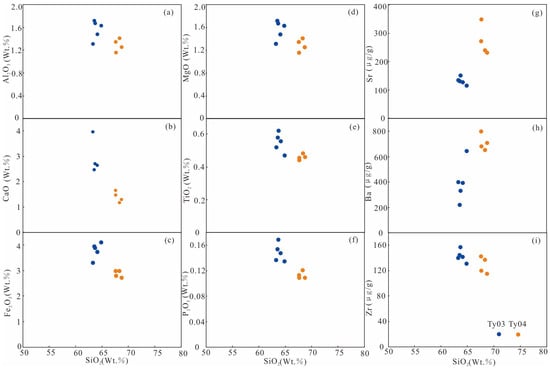
Figure 10.
Harker plots of selected major and trace elements against SiO2 for the Taoyuan syenogranite. (a) SiO2 content increases, while concentrations of Al2O3 decrease; (b) SiO2 content increases, while concentrations of CaO decrease; (c) SiO2 content increases, while concentrations of Fe2O3 decrease; (d) SiO2 content increases, while concentrations of MgO decrease; (e) SiO2 content increases, while concentrations of TiO2 decrease; (f) SiO2 content increases, while concentrations of P2O5 decrease; (g) SiO2 content increases, while concentrations of Sr increases; (h) SiO2 content increases, while concentrations of Ba increases; (i) SiO2 content increases, while concentrations of Zr increases decrease. Data sources are in Table S3.
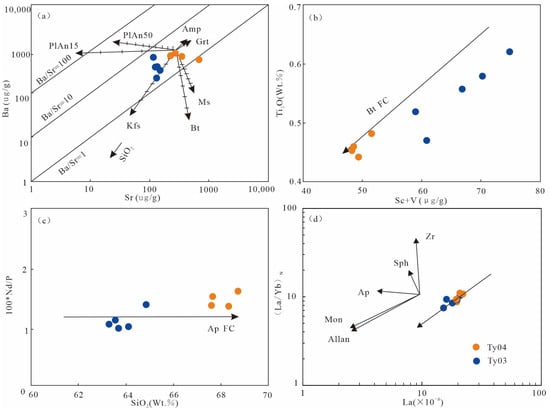
Figure 11.
Element variation diagrams for the syenogranite. (a) Ba vs. Sr, showing Ty03 closely follows the K-feldspar fractionation line; (b) TiO2 vs. Sc + V, showing strong positive correlation; (c) 100 × Nd/P vs. SiO2, showing nearly constant Nd/P ratios; (d) (La/Yb)N vs. La indicate the evolution line parallel to allanite and monazite. The vectors show the fractionation effect of biotite (Bt), K-feldspar (Kfs), plagioclase (Pl), monazite (Mon), allanite (Allan), sphene (Sph), zircon (Zr), and apatite (Ap). Data sources are in Table S3. (a) after Hanson, 1978 [106].
The strong positive correlation between Sc + V and TiO2 (Figure 11b) confirms biotite as a fractionating phase. Decreasing P2O5 with SiO2 along with nearly constant Nd/P ratios suggest apatite removal (Figure 11c). The wide data scatter in the LaN/YbN–La diagram (Figure 11d) likely reflects the variable fractionation of REE-rich accessory minerals (e.g., allanite, apatite, and sphene).
In summary, the syenite shows no significant crustal contamination. The feldspars were not early-fractionating phases in the granite. The magmatic evolution was dominantly controlled by the fractionation of biotite and REE-rich minerals (allanite, apatite, and monazite).
6.3.2. Mantle Metasomatism by Subduction-Derived Fluids and Sediment Melts
The Taoyuan syenogranite exhibited enriched LREEs and LILEs, along with depletions in Nb, Ta, P, and Ti (Figure 7), displaying a “crust-like” enriched signature [107]. This enriched geochemical signature is primarily controlled by two magmatic processes: (1) significant crustal contamination during late-stage magmatic evolution [108,109,110], (2) mantle source metasomatism prior to the generation of parental magmas [108,111,112]. The following evidence opposes crustal contamination during magma evolution, indicating that the “crustal like” enrichment characteristics of the Taoyuan syenogranite may reflect pre-magmatic mantle metasomatism. Firstly, previous studies have demonstrated that significant crustal contamination during magmatic evolution would result in abundant ancient zircon age populations during U–Pb geochronological analysis [111]. However, the Taoyuan syenogranite yields entirely concordant U–Pb ages (Figure 5), with no evidence of ancient age populations. Secondly, crustal contamination leads to negative Nb, Ta, and Ti anomalies along with slightly positive Zr and Hf anomalies [12,62,113]. Although the Taoyuan syenogranite exhibits marked depletions in Nb, Ta, and Ti, it lacks significant Zr and Hf enrichments relative to Nd and Sm (Figure 7). Furthermore, the samples display homogeneous zircon Hf isotopic compositions (εHf(t) = +8.8 to +10.9, ~2 εHf(t) units; Figure 9a,b), and the absence of mafic enclaves or disequilibrium mineral textures (Figure 2) precluding magma mixing between mafic and felsic melts [94,111].
Extensive studies have shown that in arc magmatic systems, depleted mantle sources can be modified by enriched components, such as LILE-rich subduction-derived fluids, sediment melts, or slab melts [7,111,114,115,116,117,118,119,120]. The following combination of evidence excludes the contribution of slab melt. Generally, Y behavior is controlled by slab melts [118,121,122]. Slab melts, which are Y-depleted due to garnet retention in the slab residue, elevate the Nb/Y ratios of metasomatized mantle-derived melts [56,77]. In contrast, fluid-related metasomatism produces melts with high Rb/Y ratios and Ba contents [122]. Similar to the Golovin and Belaya arc volcanic rocks in Kamchatka [122], the Taoyuan syenogranite exhibits variable Rb/Y (1.24–4.01) and Ba (219–800 ppm) values but limited Nb/Y (0.45–0.70) ratios (Figure 12a,b), indicating that their mantle source was metasomatized primarily by subduction-derived fluids rather than slab melts. In addition, the Taoyuan syenogranite has low ΣREE (99.1–120.5 ppm) and HFSE (e.g., Nb = 6.25–8.62 ppm, Zr = 115–157 ppm, Hf = 2.96–3.79 ppm) contents, which differ significantly from slab melt-modified arc lavas (e.g., [122,123]), suggesting a negligible influence of slab melts on their mantle source.
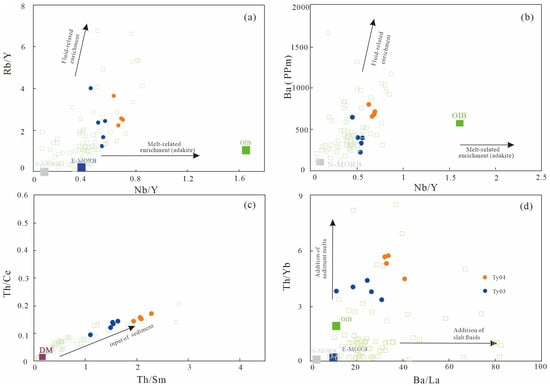
Figure 12.
Plots of fluids and sediment-derived melts. Rb/Y vs. Nb/Y (a), and Ba vs. Nb/Y (b) showing the fluid-related enrichment trend. Th/Ce vs. Th/Sm (c) showing input of sediment; Th/Yb vs. Ba/La (d) showing input of fluids and sediment-derived melts. Vectors in a-d show the trends in addition of slab-derived fluids and sediment-derived melts, after Kepezhinskas et al. (1997) [122] and Hanyu et al. (2006) [118]. Data sources are in Table S3. The light green square datas are from the 880–876 Ma gabbro–diorite, gabbro, and diorite in the Bikou Terrane [89,90,91], and the 879 Ma gabbro in the Hannan Terrane [17].
The Taoyuan syenogranite is deeply modified by subducting fluids. Firstly, its high Ba/Th and Sr/Nd ratios, along with low Nb/La and Nb/U values (compared with the primitive mantle values of Nb/La ≈ 1 and Nb/U ≈ 47), indicate the modification of the mantle source by subduction-derived fluids. Secondly, experimental petrology further demonstrates that the hydrous melting of upper mantle peridotite is a plausible mechanism for generating high-Mg magmas [120]. The calc-alkaline affinity (Figure 6) and presence of hydrous minerals (e.g., biotite and muscovite; Figure 3) in the Taoyuan syenogranite further support a potential hydrous mantle source [118,124,125].
Minor sediment melts have been confirmed to have been added to the source area of the Taoyuan syenogranite. Firstly, in primitive mantle-normalized trace element diagrams (Figure 7), unlike the Neoproterozoic fluid-modified mantle-derived magmatism in the western Yangtze Block (e.g., the Guandaoshan mafic–intermediate rocks and Dajianshan gabbrodiorites [113,126]), the Taoyuan syenogranite lacks pronounced Th enrichment. However, its Th/Ce ratios (0.09–0.17, avg. 0.14) are higher than those of N-MORB (0.016 [62]) and comparable to global subducted sediments (0.12 [121]), suggesting minor sediment input into the mantle source. Its elevated Th/Yb ratios (3.34–5.74, avg. 4.50) relative to N-MORB (0.04; [62]) further support sediment involvement [127]. Moreover, the variable Th/Ce (0.09–0.17) and Th/Sm (1.10–2.28) ratios (Figure 12c) also attest to weak sediment-derived metasomatism [112,116]. In addition, the co-variations in Th/Yb (3.34–5.74) and Ba/La (11.19–40.78) in the Taoyuan syenogranite (Figure 12d) thus reflect joint metasomatism by subduction-derived fluids and minor sediment melts [118,127].
Therefore, we conclude that the Neoproterozoic Taoyuan syenogranite along the northern Yangtze Block margin was derived from the partial melting of a mantle source metasomatized by subduction-derived fluids and sediment melts.
6.4. Tectonic Implications
Extensive geological evidence indicates that the northwestern Yangtze Block was situated in a subduction-related tectonic environment for an extended period during the Neoproterozoic. Petrologically, the Neoproterozoic magmatic rock assemblage in this region is dominated by intermediate to felsic granitoids, accompanied by minor mafic–ultramafic rocks. Examples include basaltic andesites, ophiolites, and andesites dated at ~985–930 Ma [82,83,89,90,128], plagiogranites at 905 ± 8 Ma [129], mafic intrusions at 890 Ma [13,16,82], gabbros at 885 Ma [17,92], granites at 887 Ma [16,44], and diorites at 880 Ma [92]. This lithological assemblage distinctly differs from mantle plume-related large-scale continental flood basalts [130,131], ruling out a mantle plume-dominated magmatic model. These rocks exhibit typical arc-like trace element patterns with relatively low concentrations of incompatible elements, resembling intra-oceanic arc magmas (e.g., [132]). In the Y vs. Sr/Y and (Yb)N vs. (La/Yb)N diagrams, the values plot within the normal andesite–dacite–rhyolite series alongside the Guangwushan granites (Figure 13a,b), strongly supporting their formation in a subduction environment.
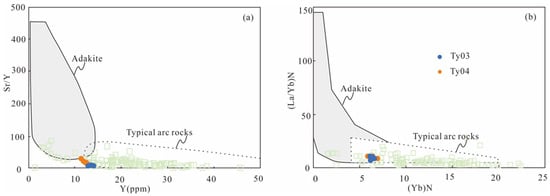
Figure 13.
The Taoyuan syenogranite in the Northern Yangtze Block, (a) Y versus Sr/Y; (b) (Yb)N versus (La/Yb)N diagrams [36]. (a,b) showing that the Taoyuan syenogranite is a typical arc rock. Green squares show data from magmatic rocks with an age greater than or equal to 880 Ma in the Northern Yangtze Block, such as [13,16,19,45,81,82,83,89,90,92].
Considering the high Rb/Y, Nb/Y, Th/Yb, Th/Sm, Th/Ce, and Ba/La ratios, we propose that the primitive mantle source of the Taoyuan syenogranite underwent metasomatism by both subduction-derived fluids and sediment melts (Figure 12a–d). Regionally, contemporaneous plutonic rocks (e.g., 880–876 Ma gabbros, diorites, and gabbro–diorites in the Bikou Terrane [89,90,91], and 879 Ma gabbros in the Hannan Complex [91]) also originated from mantle sources metasomatized by both subduction-derived fluids and sediment melts (Figure 12a–d). The extensive mantle metasomatism related to subduction melts along the northern Yangtze margin supports a Neoproterozoic subduction-related tectonic setting (Figure 14).
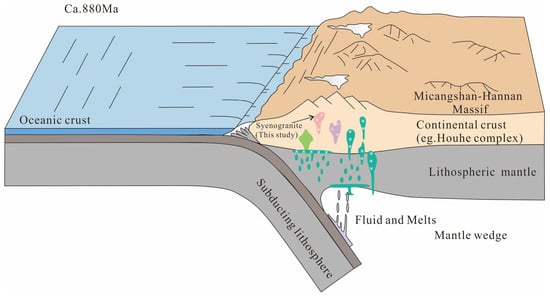
Figure 14.
Schematic cartoon showing the tectonic model along the Micangshan-Hannan Massif at ca. 880 Ma [89].
Furthermore, the >200 Myr duration of Neoproterozoic magmatism in the northwestern Yangtze Block matches the prolonged arc magmatism characteristic of Andean-type active continental margins [133], contrasting sharply with the short-lived (1–5 Myr) pulses typical of mantle plume events [131].
7. Conclusions
The LA-ICP-MS zircon U–Pb geochronological results indicate that the Taoyuan syenogranite were emplaced at ca. 880 Ma. The geochemical characteristics demonstrate that these rocks are metaluminous and calc-alkaline in composition. Their MgO contents (1.16–1.72 wt.%), Mg# values (46–48, mean 46), and positive zircon εHf(t) values (+9.2 to +10.9) collectively suggest derivation from a depleted lithospheric mantle source. Considering the negligible crustal contamination and relatively enriched geochemical signatures (e.g., elevated Ba and Th contents, high Rb/Y, Nb/Y, Th/Yb, Th/Sm, Th/Ce, and Ba/La ratios), we propose that the primitive mantle source of the Taoyuan syenogranite underwent metasomatism by both subduction-derived fluids and sediment melts. The extensive crust–mantle interaction documented here provides robust evidence for a subduction-related tectonic setting along the northwestern margin of the Yangtze Block during the early Neoproterozoic.
Supplementary Materials
The following supporting information can be downloaded at: https://www.mdpi.com/article/10.3390/min15070730/s1, Table S1. Zircon U-Pb isotopic data for Taoyuan Syenogranite samples Ty03 and Ty04 of the Micangshan missif, northern Yangtze Craton; Table S2. Zircon Lu-Hf isotopic data for Taoyuan Syenogranite samples Ty03 and Ty04 of the Micangshan missif, northern Yangtze Craton; Table S3. Whole-rock major and trace elemets for Taoyuan Syenogranite of the Micangshan missif, northern Yangtze Craton.
Author Contributions
Writing—original draft, S.L.; resources, S.L. and P.W.; conceptualization, S.L. and H.L.; supervision, H.L. and P.W.; writing—review and editing, H.L. and P.W.; investigation, F.C., S.L., S.Z. and P.W.; Visualization and Editing, Y.L. All authors have read and agreed to the published version of the manuscript.
Funding
This research was funded by the National Natural Science Foundation of China (No. 41802137) and the Regional Geological and Mineral Survey Project (DD20240207803).
Data Availability Statement
The data are contained within this article.
Acknowledgments
The authors are thankful to the reviewers and scientific editor, whose constructive criticism and recommendations helped us to significantly rework and improve the manuscript.
Conflicts of Interest
Yiduo Li was employed by the Xi’an Northwest Non-ferrous Geophysical and Chemical Exploration Group Co., Ltd. The remaining authors declare that the research was conducted in the absence of any commercial or financial relationships that could be construed as a potential conflict of interest.
References
- Li, Z.X.; Li, X.H.; Kinny, P.D.; Wang, J. The Breakup of Rodinia: Did It Start with a Mantle Plume beneath South China? Earth Planet. Sci. Lett. 1999, 173, 171–181. [Google Scholar] [CrossRef]
- Li, Z.X.; Bogdanova, S.V.; Collins, A.S.; Davidson, A.; De Waele, B.; Ernst, R.E.; Fitzsimons, I.C.W.; Fuck, R.A.; Gladkochub, D.P.; Jacobs, J.; et al. Assembly, Configuration, and Break-up History of Rodinia: A Synthesis. Precambrian Res. 2008, 160, 179–210. [Google Scholar] [CrossRef]
- Li, X.H.; Li, Z.X.; Zhou, H.W.; Liu, Y.; Kinny, P.D. U–Pb Zircon Geochronology, Geochemistry and Nd Isotopic Study of Neoproterozoic Bimodal Volcanic Rocks in the Kangdian Rift of South China: Implications for the Initial Rifting of Rodinia. Precambrian Res. 2002, 113, 135–154. [Google Scholar] [CrossRef]
- Dong, Y.; Liu, X.; Santosh, M.; Chen, Q.; Zhang, X.; Li, W.; He, D.; Zhang, G. Neoproterozoic Accretionary Tectonics along the Northwestern Margin of the Yangtze Block, China: Constraints from Zircon U–Pb Geochronology and Geochemistry. Precambrian Res. 2012, 196–197, 247–274. [Google Scholar] [CrossRef]
- Dong, Y.P.; Sun, S.S.; Yang, Z.; Liu, X.M.; Zhang, F.F.; Li, W.; Cheng, B.; He, D.F.; Zhang, G.W. Neoproterozoic Subduction-Accretionary Tectonics of the South Qinling Belt, China. Precambrian Res. 2017, 293, 73–90. [Google Scholar] [CrossRef]
- Shu, L.Y. An analysis of principal features of tectonic evolution in south China block. Geol. Bull. China 2012, 31, 1035–1053. [Google Scholar]
- Zhao, J.H.; Li, Q.W.; Liu, H.; Wang, W. Neoproterozoic Magmatism in the Western and Northern Margins of the Yangtze Block (South China) Controlled by Slab Subduction and Subduction-Transform-Edge-Propagator. Earth Sci. Rev. 2018, 187, 1–18. [Google Scholar] [CrossRef]
- Yao, J.L.; Cawood, P.A.; Shu, L.S.; Zhao, G.C. Jiangnan Orogen, South China: A ~970–820 ma Rodinia Margin Accretionary Belt. Earth Sci. Rev. 2019, 196, 102872. [Google Scholar] [CrossRef]
- Cawood, P.A.; Wang, W.; Zhao, T.Y.; Xu, Y.J.; Mulder, J.A.; Pisarevsky, S.A.; Zhang, L.M.; Gan, C.S.; He, H.Y.; Liu, H.; et al. Deconstructing South China and Consequences for Reconstructing Nuna and Rodinia. Earth Sci. Rev. 2020, 204, 103169. [Google Scholar] [CrossRef]
- Li, X.H.; Li, Z.-X.; Ge, W.; Zhou, H.; Li, W.; Liu, Y.; Wingate, M.T.D. Neoproterozoic Granitoids in South China: Crustal Melting above a Mantle Plume at ca. 825 Ma? Precambrian Res. 2003, 122, 45–83. [Google Scholar] [CrossRef]
- Zhou, M.F.; Yan, D.P.; Kennedy, A.K.; Li, Y.Q.; Ding, J. SHRIMP U–Pb Zircon Geochronological and Geochemical Evidence for Neoproterozoic Arc-Magmatism along the Western Margin of the Yangtze Block, South China. Earth Planet. Sci. Lett. 2002, 196, 51–67. [Google Scholar] [CrossRef]
- Zhou, M.F.; Ma, Y.X.; Yan, D.P.; Xia, X.P.; Zhao, J.P.; Sun, M. The Yanbian Terrane (Southern Sichuan Province, SW China): A Neoproterozoic Arc Assemblage in the Western Margin of the Yangtze Block. Precambrian Res. 2006, 144, 19–38. [Google Scholar] [CrossRef]
- Dong, Y.P.; Liu, X.M.; Santosh, M.; Zhang, X.; Chen, Q.; Yang, C.; Yang, Z. Neoproterozoic Subduction Tectonics of the Northwestern Yangtze Block in South China: Constrains from Zircon U–Pb Geochronology and Geochemistry of Mafic Intrusions in the Hannan Massif. Precambrian Res. 2011, 189, 66–90. [Google Scholar] [CrossRef]
- Zheng, Y.F.; Zhang, S.B.; Zhao, Z.F.; Wu, Y.B.; Li, X.H.; Li, Z.X.; Wu, F.Y. Contrasting Zircon Hf and O Isotopes in the Two Episodes of Neoproterozoic Granitoids in South China: Implications for Growth and Reworking of Continental Crust. Lithos 2007, 96, 127–150. [Google Scholar] [CrossRef]
- Zheng, Y.F.; Wu, R.X.; Wu, Y.B.; Zhang, S.B.; Yuan, H.L.; Wu, F.-Y. Rift Melting of Juvenile Arc-Derived Crust: Geochemical Evidence from Neoproterozoic Volcanic and Granitic Rocks in the Jiangnan Orogen, South China. Precambrian Res. 2008, 163, 351–383. [Google Scholar] [CrossRef]
- Zhou, J.L.; Li, X.H.; Tang, G.Q.; Gao, B.-Y.; Bao, Z.-A.; Ling, X.X.; Wu, L.G.; Lu, K.; Zhu, Y.S.; Liao, X. 890 ma Magmatism in the Northwest Yangtze Block, South China: SIMS U-Pb Dating, in-Situ Hf-O Isotopes, and Tectonic Implications. J. Asian Earth Sci. 2018, 151, 101–111. [Google Scholar] [CrossRef]
- Luo, B.J.; Liu, R.; Zhang, H.F.; Zhao, J.L.; Yang, H.; Xu, W.C.; Guo, L.; Zhang, L.Q.; Tao, L.; Pan, F.B.; et al. Neoproterozoic Continental Back-Arc Rift Development in the Northwestern Yangtze Block: Evidence from the Hannan Intrusive Magmatism. Gondwana Res. 2018, 59, 27–42. [Google Scholar] [CrossRef]
- Berkana, W.; Wu, H.; Ling, W.L.; Kusky, T.; Ding, X.Y. Neoproterozoic Metavolcanic Suites in the Micangshan Terrane and Their Implications for the Tectonic Evolution of the NW Yangtze Block, South China. Precambrian Res. 2022, 368, 106476. [Google Scholar] [CrossRef]
- Gan, B.P.; Lai, S.C.; Qin, J.F.; Zhu, R.Z.; Zhao, S.W.; Li, T. Neoproterozoic Alkaline Intrusive Complex in the Northwestern Yangtze Block, Micang Mountains Region, South China: Petrogenesis and Tectonic Significance. Int. Geol. Rev. 2017, 59, 311–332. [Google Scholar] [CrossRef]
- Hui, B.; Dong, Y.P.; Liu, G.; Zhao, H.Y.Z.; Sun, S.S.; Zhang, F.F. Origin of mafic intrusions in the Micangshan Massif, Central China: Implications for the Neoproterozoic tectonic evolution of the northwestern Yangtze Block. J. Asian Earth Sci. 2020, 190, 104132. [Google Scholar] [CrossRef]
- Ao, W.H. Petrography, Geochemistry, Zircon Geochronology and Geological Implications of Neoproterozoic Granites in Dahanshan Region, Northern Margin of Yangtze Plate. Master’s Thesis, Northwest University, Kirkland, WA, USA, 2015. (In Chinese with English Abstract). [Google Scholar]
- Deng, Q.; Wang, J.; Wang, Z.J.; Jiang, X.S.; Du, Q.D.; Wu, H.; Yang, F.; Cui, X.Z. Zircon U–Pb ages for tuffs from the Dashigou and Sanlangpu Formations of the Xixiang Group in the northern margin of the Yangtze Block and their geological significance. J. Jilin Univ. (Earth Sci. Ed.) 2013, 43, 797–819, (In Chinese with English Abstract). [Google Scholar]
- Gan, B.P. Neoproterozoic Alkaline Complex in the Northern Yangtze Block, Micangshan Mountains Area: Geological Significances and Geological Implications. Master’s Thesis, Northwest University, Kirkland, WA, USA, 2015. (In Chinese with English Abstract). [Google Scholar]
- Geng, Y.Y. SHRIMP U–Pb Zircon Geochronology and Geochemistry Study of Neoproterozoic Granites in the Northern Margin of Yangtze Continental. Master’s Thesis, China University of Geoscience, Beijing, China, 2010. (In Chinese with English Abstract). [Google Scholar]
- Li, T. The Study of Neoproterozoic Tectonic-Magmatic Events in the Northern Margin of the Yangtze Continental. Master’s Thesis, Chang’an University, Xi’an, China, 2010. (In Chinese with English Abstract). [Google Scholar]
- Ling, W.L.; Gao, S.; Zhang, B.; Li, H.M.; Liu, Y.; Cheng, J.P. Neoproterozoic Tectonic Evolution of the Northwestern Yangtze Craton, South China: Implications for Amalgamation and Break-up of the Rodinia Supercontinent. Precambrian Res. 2003, 122, 111–140. [Google Scholar] [CrossRef]
- Ling, W.L.; Gao, S.; Cheng, J.P.; Jiang, L.S.; Yuan, H.L.; Hu, Z.C. Neoproterozoic magmatic events within the yangtze continental interior and along its northern margin and their tectonic implication: Constraint from the ELA-ICPMS U-pb geochronology of zircons from the huangling and hannan complexes. Acta Petrol. Sin. 2006, 22, 387–396. [Google Scholar]
- Liu, R.; Zhang, B.R.; Zhang, H.F.; Yuan, H.L. U-Pb zircon age, geochemical and SrNd-Hf isotopic compositions of neoproterozoic granitoids in northwestern margin of Yangtze block (South China): Implications for neoproterozoic tectonic evolution. J. Earth Sci. 2009, 20, 659–680. [Google Scholar] [CrossRef]
- Wang, M.X.; Nebel, O.; Wang, C.Y. The Flaw in the Crustal “Zircon Archive”: Mixed Hf Isotope Signatures Record Progressive Contamination of Late-Stage Liquid in Mafic-Ultramafic Layered Intrusions. J. Petrol. 2016, 57, 27–52. [Google Scholar] [CrossRef]
- Xia, L.Q.; Xia, Z.C.; Ma, Z.P.; Xu, X.Y.; Li, X.M. Petrogenesis of volcanic rocks from Xixiang Group in middle part of South Qinling Mountains. Northwest. Geol. 2009, 42, 1–37, (In Chinese with English Abstract). [Google Scholar]
- Zhao, J.H.; Zhou, M.F. Neoproterozoic adakitic plutons in the northern margin of the Yangtze Block, China: Partial melting of a thickened lower crust and implications for secular crustal evolution. Lithos 2008, 104, 231–248. [Google Scholar] [CrossRef]
- Zhao, J.H.; Zhou, M.F. Melting of newly formed mafic crust for the formation of Neoproterozoic I-type granite in the Hannan region, South China. J. Geol. 2009, 117, 54–70. [Google Scholar] [CrossRef]
- Zhao, J.H.; Zhou, M.F. Secular evolution of the Neoproterozoic lithospheric mantle underneath the northern margin of the Yangtze Block, South China. Lithos 2009, 107, 152–168. [Google Scholar] [CrossRef]
- Zhao, F.Q.; Zhao, W.P.; Zuo, Y.C.; Li, Z.H.; Xue, K.Q. U-Pb geochronology of Neoproterozoic magmatic rocks in Hanzhong, southern Shaanxi, China. Geol. Bull. China 2006, 25, 383–388, (In Chinese with English Abstract). [Google Scholar]
- Zhao, J.H.; Zhou, M.F.; Zheng, J.P.; Fang, S.M. Neoproterozoic crustal growth and reworking of the Northwestern Yangtze Block: Constraints from the Xixiang dioritic intrusion, South China. Lithos 2010, 120, 439–452. [Google Scholar] [CrossRef]
- Zhou, M.F.; Kennedy, A.K.; Sun, M.; Malpas, J.; Lesher, C.M. Neoproterozoic arcrelated mafic intrusions along the northern margin of South China: Implications for the accretion of Rodinia. J. Geol. 2002, 110, 611–618. [Google Scholar] [CrossRef]
- Zhu, X.; Long, X.P.; Yang, X.X.; Wang, J.Y. The formation temperature of Neoproterozoic magmatic intrusions in the Hannan area and its geological significance. Chin. J. Geol. 2018, 53, 1000–1026, (In Chinese with English Abstract). [Google Scholar]
- Gao, S.; Ling, W.L.; Qiu, Y.; Lian, Z.; Hartmann, G.; Simon, K. Contrasting Geochemical and Sm-Nd Isotopic Compositions of Archean Metasediments from the Kongling High-Grade Terrain of the Yangtze Craton: Evidence for Cratonic Evolution and Redistribution of REE during Crustal Anatexis. Geochim. Cosmochim. Acta 1999, 63, 2071–2088. [Google Scholar] [CrossRef]
- Wu, Y.B.; Gao, S.; Zhang, H.F.; Zheng, J.P.; Liu, X.C.; Wang, H.; Gong, H.J.; Zhou, L.; Yuan, H.Q. Geochemistry and Zircon U–Pb Geochronology of Paleoproterozoic Arc Related Granitoid in the Northwestern Yangtze Block and Its Geological Implications. Precambrian Res. 2012, 200–203, 26–37. [Google Scholar] [CrossRef]
- Deng, Q.; Wang, Z.J.; Ren, G.M.; Cui, X.Z. Discovery of the Baiyu ~1.79 Ga a-Type Granite in the Beiba Area of the Northwestern Margin of Yangtze Block: Constraints on Tectonic Evolution of South China. Acta Geol. Sin. 2017, 91, 1454–1466. [Google Scholar]
- Deng, Q.; Wang, Z.J.; Ren, G.M.; Cui, X.Z. Identification of the ~2.09 Ga and ~1.76 Ga Granitoids in the Northwestern Yangtze Block: Records of the Assembly and Break-Up of Columbia Supercontinent. Earth Sci. 2020, 45, 3295–3312. [Google Scholar]
- Deng, Q.; Ren, G.M.; Wang, Z.J.; Ning, K.B.; Cui, X.Z. Depositional age, provenance and tectonic significance of the Huodiya Group in the Wangcang area, northwestern margin of the Yangtze Block: Constraints from detrital zircon U-Pb geochronology. Acta Sedimentol. Sin. 2024, 42, 1948–1957. [Google Scholar]
- Wei, G.A.; Zhou, G.F.; Pan, W.Q. Geochronology, Geochemistry and Tectonic Significance of Potash Feldspar in Guangwushan area, northern margin of Yangtze plate. J. Mineral. Petrol. 2019, 39, 14–24. [Google Scholar]
- Ao, W.H.; Zhao, Y.; Zhang, Y.K.; Zhai, M.G.; Zhang, H.; Zhang, R.; Wang, Q.; Sun, Y. The Neoproterozoic Magmatism in the Northern Margin of the Yangtze Block: Insights from Neoproterozoic (950–706 Ma) Gabbroic-Granitoid Rocks of the Hannan Complex. Precambrian Res. 2019, 333, 105442. [Google Scholar] [CrossRef]
- Li, F.L.; Li, Y.L.; Zhou, G.H.; Xu, S.Y.; Li, Z.G.; Zhou, H.W. LA-ICP-MS zircon U-pb dating of schist from the Dalangshan group in Suizhou city, Hubei province, and its implications. Acta Petrol. Mineral. 2010, 29, 488–496. [Google Scholar]
- Zong, K.Q.; Klemd, R.; Yuan, Y.; He, Z.Y.; Guo, J.L.; Shi, X.L.; Liu, Y.S.; Hu, Z.C.; Zhang, Z.M. The Assembly of Rodinia: The Correlation of Early Neoproterozoic (ca. 900 Ma) High-Grade Metamorphism and Continental Arc Formation in the Southern Beishan Orogen, Southern Central Asian Orogenic Belt (CAOB). Precambrian Res. 2017, 290, 32–48. [Google Scholar] [CrossRef]
- Wiedenbeck, M.; Alle, P.; Corfu, F.; Griffin, W.L.; Meier, M.; Oberli, F.; Von Quadt, A.; Roddick, J.C.; Spiegel, W. Three natural zircon standards for U-Th-Pb, Lu-Hf, trace element and REE analyses. Geostand. Newsl. 1995, 19, 1–23. [Google Scholar] [CrossRef]
- Pearce, N.J.; Perkins, W.T.; Westgate, J.A.; Gorton, M.P.; Jackson, S.E.; Neal, C.R.; Chenery, S.P. A compilation of new and published major and trace element data for NIST SRM 610 and NIST SRM 612 glass reference materials. Geostand. Geoanal. Res. 1997, 21, 115–144. [Google Scholar] [CrossRef]
- Liu, Y.S.; Gao, S.; Cheng, J.P.; Jiang, L.S.; Yuan, H.L.; Hu, Z. Continental and Oceanic Crust Recycling-Induced Melt-Peridotite Interactions in the Trans-North China Orogen: U-Pb Dating, Hf Isotopes and Trace Elements in Zircons of Mantle Xenoliths. J. Petrol. 2010, 51, 537–571. [Google Scholar] [CrossRef]
- Ludwig, K.R. ISOPLOT 3.00: A Geochronological Toolkit for Microsoft Excel; Berkeley Geochronology Center: Berkeley, CA, USA, 2003. [Google Scholar]
- Hu, Z.C.; Zhang, W.; Liu, Y.S.; Gao, S.; Li, M. “Wave” Signal-Smoothing and Mercury-Removing Device for Laser Ablation Quadrupole and Multiple Collector ICPMS Analysis: Application to Lead Isotope Analysis. Anal. Chem. 2015, 87, 1152–1157. [Google Scholar] [CrossRef]
- Liu, Y.S.; Hu, Z.C.; Gao, S.; Günther, D.; Xu, J.; Gao, C.G.; Chen, H.H. In situ analysis of major and trace elements of anhydrous minerals by LA-ICP-MS without applying an internal standard. Chem. Geol. 2008, 257, 34–43. [Google Scholar] [CrossRef]
- Jonathan Patchett, P. Hafnium Isotope Results from Mid-Ocean Ridges and Kerguelen. Lithos 1983, 16, 47–51. [Google Scholar] [CrossRef]
- Maniar, P.D.; Piccoli, P.M. Tectonic Discrimination of Granitoids. Geol. Soc. Am. Bull. 1989, 101, 635–643. [Google Scholar] [CrossRef]
- Rollinson, H. Using Geochemical Data: Evaluation, Presentation, Interpretation; Longman Scientific and Technical: London, UK, 1993. [Google Scholar]
- Defant, M.J.; Drummond, M.S. Derivation of Some Modern Arc Magmas by Melting of Young Subducted Lithosphere. Nature 1990, 347, 662–665. [Google Scholar] [CrossRef]
- Castillo, P.R.; Janney, P.E.; Solidum, R.U. Petrology and Geochemistry of Camiguin Island, Southern Philippines: Insights to the Source of Adakites and Other Lavas in a Complex Arc Setting. Contrib. Mineral. Petrol. 1999, 134, 33–51. [Google Scholar] [CrossRef]
- Castillo, P.R. An Overview of Adakite Petrogenesis. Chin. Sci. Bull. 2006, 51, 257–268. [Google Scholar] [CrossRef]
- Castillo, P.R. Adakite Petrogenesis. Lithos 2012, 134–135, 304–316. [Google Scholar] [CrossRef]
- Macpherson, C.G.; Dreher, S.T.; Thirlwall, M.F. Adakites without Slab Melting: High Pressure Differentiation of Island Arc Magma, Mindanao, the Philippines. Earth Planet. Sci. Lett. 2006, 243, 581–593. [Google Scholar] [CrossRef]
- Kolb, M.; Von Quadt, A.; Peytcheva, I.; Heinrich, C.A.; Fowler, S.J.; Cvetkovic, V. Adakite-like and Normal Arc Magmas: Distinct Fractionation Paths in the East Serbian Segment of the Balkan–Carpathian Arc. J. Petrol. 2013, 54, 421–451. [Google Scholar] [CrossRef]
- Sun, S.S.; McDonough, W.F. Chemical and Isotopic Systematics of Oceanic Basalts: Implications for Mantle Composition and Processes. ResearchGate 1989, 42, 313–345. [Google Scholar] [CrossRef]
- Chappell, B.W. Aluminium Saturation in I- and S-Type Granites and the Characterization of Fractionated Haplogranites—ScienceDirect. Lithos 1999, 46, 535–551. [Google Scholar] [CrossRef]
- Whalen, J.B.; Currie, K.L.; Chappell, B.W. A-Type Granites: Geochemical Characteristics and Discrimination. Contrib. Mineral. Petrol. 1987, 95, 420–436. [Google Scholar] [CrossRef]
- Bernard, B. A-Type Granites and Related Rocks: Evolution of a Concept, Problems and Prospects. Lithos 1987, 97, 1–29. [Google Scholar]
- King, P.L.; Chappell, B.W.; Allen, C.M.; White, A.J.R. Are A-Type Granites the High-Temperature Felsic Granites? Evidence from fractionated granites of the Wangrah Suite. Aust. J. Earth Sci. 2001, 48, 501–504. [Google Scholar] [CrossRef]
- Watson, E.B.; Harrison, T.M. Zircon Saturation Revisited: Temperature and Composition Effects in a Variety of Crustal Magma Types. Earth Planet. Sci. Lett. 1983, 64, 295–304. [Google Scholar] [CrossRef]
- Liu, C.S.; Chen, X.M.; Chen, P.R.; Wang, R.C.; Hu, H. Subdivision, discrimination Criteria and Genesis for a Type Rock Suites. Geol. J. China Univ. 2003, 9, 573. [Google Scholar]
- Hine, R.; Williams, I.S.; Chappell, B.W.; White, A.J.R. Contrasts between I- and S-type Granitoids of the Kosciusko Batholith. J. Geol. Soc. Aust. 1978, 25, 219–234. [Google Scholar] [CrossRef]
- Zen, E.A. Aluminium Enrichment in Silicate Melts by Fractional Crystallization: Some Mineralogic and Petrographic Constraints. J. Petrol. 1986, 27, 1095–1117. [Google Scholar] [CrossRef]
- Zhao, B.; Deng, Y.; Zhou, T.; Yuan, F.; Zhang, D.; Li, P.; Zhang, R. Petrogenesis of the Wusan Pluton in West Junggar: Evidence from Geochronology, Petrology and Geochemistry. Acta Geol. Sin. 2016, 90, 950–970. [Google Scholar]
- Hofmann, A.W. Chemical Differentiation of the Earth: The Relationship between Mantle, Continental Crust, and Oceanic Crust. Earth Planet. Sci. Lett. 1988, 90, 297–314. [Google Scholar] [CrossRef]
- Green, T.H. Significance of Nb/Ta as an Indicator of Geochemical Processes in the Crust-Mantle System. Chem. Geol. 1995, 120, 347–359. [Google Scholar] [CrossRef]
- Taylor, S.; McLennan, S. The Continental Crust: Its Composition and Evolution; Department of Geosciences Faculty Publications; Blackwell Scientific Publications: Oxford, UK, 1985. [Google Scholar]
- Stacey, J.S.; Kramers, J.D. Approximation of Terrestrial Lead Isotope Evolution by a Two-Stage Model. Earth Planet. Sci. Lett. 1975, 26, 207–221. [Google Scholar] [CrossRef]
- Griffin, W.L.; Pearson, N.J.; Belousova, E.; Jackson, S.E.; van Achterbergh, E.; O’Reilly, S.Y.; Shee, S.R. The Hf Isotope Composition of Cratonic Mantle: LAM-MC-ICPMS Analysis of Zircon Megacrysts in Kimberlites. Geochim. Cosmochim. Acta 2000, 64, 133–147. [Google Scholar] [CrossRef]
- Rapp, R.P.; Watson, E.B. Dehydration melting of metabasalt at 8–32 kbar: Implications for continental growth and crust-mantle recycling. J. Petrol. 1995, 36, 891–931. [Google Scholar] [CrossRef]
- Dupuy, C.; Liotard, J.M.; Dostal, J. Zr/Hf Fractionation in Intraplate Basaltic Rocks: Carbonate Metasomatism in the Mantle Source. Geochim. Cosmochim. Acta 1992, 56, 2417–2423. [Google Scholar] [CrossRef]
- Smith, E.I.; Sánchez, A.; Walker, J.D.; Wang, K. Geochemistry of Mafic Magmas in the Hurricane Volcanic Field, Utah: Implications for Small- and Large-scale Chemical Variability of the Lithospheric Mantle. J. Geol. 1999, 107, 433–448. [Google Scholar] [CrossRef]
- Yan, M.; Liu, S.W.; Li, Q.G.; Yang, P.T.; Wang, W.; Guo, R.R.; Bai, X.; Deng, Z.B. LAICPMS zircon U-Pb chronology and Lu-Hf isotopic features of the Mihunzhen pluton in the South Qinling tectonic belt. Acta Petrol. Sin. 2014, 30, 390–400, (In Chinese with English Abstract). [Google Scholar]
- Xu, Y.; Yang, K.G.; Polat, A.; Yang, Z.N. The ∼860 Ma mafic dikes and granitoids from the northern margin of the Yangtze Block, China: A record of oceanic subduction in the early Neoproterozoic. Precambrian Res. 2016, 275, 310–331. [Google Scholar] [CrossRef]
- Wu, P.; Zhang, S.B.; Zheng, Y.F.; Fu, B.; Liang, T. Amalgamation of South China into Rodinia during the Grenvillian Accretionary Orogeny: Geochemical Evidence from Early Neoproterozoic Igneous Rocks in the Northern Margin of the South China Block. Precambrian Res. 2019, 321, 221–243. [Google Scholar] [CrossRef]
- Wu, P.; Zhang, S.B.; Li, Z.X.; Wu, Y.B.; Zheng, Y.-F. Secular Change in the Nature of Mantle and Tectonic Evolution of Northwestern Margin of the Yangtze Block during Neoproterozoic: Constraints from the Mafic Intrusions and Associated Granitoids of the Hannan and Xiaomoling Complexes. Precambrian Res. 2023, 393, 107094. [Google Scholar] [CrossRef]
- Wang, R.; Xu, Z.; Santosh, M.; Zeng, B. Mid-Neoproterozoic magmatism in the northern margin of the Yangtze Block, South China: Implications for transition from subduction to post-collision. Precambrian Res. 2021, 354, 106073. [Google Scholar] [CrossRef]
- Huang, Y.; Wang, X.-L.; Li, J.-Y.; Li, R.-C.; Du, D.-H.; Jiang, C.-H.; Li, L.-S.; Ding, N. From arc accretion to within-plate extension: Geochronology and geochemistry of the Neoproterozoic magmatism on the northern margin of the Yangtze Block. Precambrian Res. 2023, 395, 107133. [Google Scholar] [CrossRef]
- Rapp, R.P.; Shimizu, N.; Norman, M.D.; Applegate, G.S. Reaction between Slab-Derived Melts and Peridotite in the Mantle Wedge: Experimental Constraints at 3.8 GPa. Chem. Geol. 1999, 160, 335–356. [Google Scholar] [CrossRef]
- Stern, C.R.; Kilian, R. Role of the Subducted Slab, Mantle Wedge and Continental Crust in the Generation of Adakites from the Andean Austral Volcanic Zone. Contrib. Mineral. Petrol. 1996, 123, 263–281. [Google Scholar] [CrossRef]
- Smithies, R.H.; Champion, D.C. The Archaean high-Mg diorite suite: Links totonalite–trondhjemite–granodiorite magmatism and implications for Early Archaean crustal growth. J. Petrol. 2000, 41, 1653–1671. [Google Scholar] [CrossRef]
- Hui, B.; Dong, Y.P.; Zhang, F.F.; Sun, S.S.; He, S. Petrogenesis and Tectonic Implications of the Neoproterozoic Mafic Intrusions in the Bikou Terrane along the Northwestern Margin of the Yangtze Block, South China. Ore Geol. Rev. 2021, 131, 104014. [Google Scholar] [CrossRef]
- Xiao, L.; Zhang, H.F.; Ni, P.Z.; Xiang, H.; Liu, X.M. LA-ICP-MS U–Pb Zircon Geochronology of Early Neoproterozoic Mafic-Intermediat Intrusions from NW Margin of the Yangtze Block, South China: Implication for Tectonic Evolution. Precambrian Res. 2007, 154, 221–235. [Google Scholar] [CrossRef]
- Wang, W.; Liu, S.W.; Feng, Y.G.; Li, Q.G.; Wu, F.H.; Wang, Z.; Wang, R.; Yang, P.T. Chronology, Petrogenesis and Tectonic Setting of the Neoproterozoic Tongchang Dioritic Pluton at the Northwestern Margin of the Yangtze Block: Constraints from Geochemistry and Zircon U–Pb–Hf Isotopic Systematics. Gondwana Res. 2012, 22, 699–716. [Google Scholar] [CrossRef]
- Hu, F.Y.; Liu, S.W.; Santosh, M.; Deng, Z.B.; Wang, W.; Zhang, W.; Yan, M. Chronology and Tectonic Implications of Neopro-terozoic Blocks in the South Qinling Orogenic Belt, Central China. Gondwana Res. 2016, 30, 24–47. [Google Scholar] [CrossRef]
- Belousova, E.A.; Griffin, W.L.; O’REilly, S.Y. Zircon Crystal Morphology, Trace Element Signatures and Hf Isotope Composition as a Tool for Petrogenetic Modelling: Examples from Eastern Australian Granitoids. J. Petrol. 2006, 47, 329–353. [Google Scholar] [CrossRef]
- Kemp, A.I.S.; Hawkesworth, C.J.; Foster, G.L.; Paterson, B.A.; Woodhead, J.D.; Hergt, J.M.; Gray, C.M.; Whitehouse, M.J. Magmatic and Crustal Differentiation History of Granitic Rocks from Hf-O Isotopes in Zircon. Science 2007, 315, 980–983. [Google Scholar] [CrossRef] [PubMed]
- Wu, F.Y.; Yang, Y.-H.; Xie, L.-W.; Yang, J.-H.; Xu, P. Hf Isotopic Compositions of the Standard Zircons and Baddeleyites Used in U–Pb Geochronology. Chem. Geol. 2006, 234, 105–126. [Google Scholar] [CrossRef]
- Vervoort, J.D.; Patchett, P.J.; Blichert-Toft, J.; Albarède, F. Relationships between Lu–Hf and Sm–Nd Isotopic Systems in the Global Sedimentary System. Earth Planet. Sci. Lett. 1999, 168, 79–99. [Google Scholar] [CrossRef]
- Lin, Y.P.; Ci, D.; Zhao, H.F. Zircon U-pb age, geochemistry and geological significances of the biotite monzogranite in lhasa rock mass, tibet. Sediment. Geol. Tethyan Geol. 2020, 40, 56–70. [Google Scholar] [CrossRef]
- Song, D.H.; Wang, Y.; Liu, B. Age, Petrogenesis and Tectonic Implications of Late Mesoproterozoic Yuanmou Granite in the Western Yangtze Block, South China. Sediment. Geol. Tethyan Geol. 2023, 43, 661–673. [Google Scholar]
- Zhang, H.; Lu, S.L.; Gio, W.K. Petrogenesis of Slab-Derived Trondhjemite–Tonalite–Dacite/Adakite Magmas|Earth and Environmental Science Transactions of the Royal Society of Edinburgh|Cambridge Core. Sediment. Geol. Tethyan Geol. 2024, 44, 740–756. [Google Scholar]
- Barnes, S.J.; Naldrett, A.J.; Gorton, M.P. The Origin of the Fractionation of Platinum-Group Elements in Terrestrial Magmas. Chem. Geol. 1985, 53, 303–323. [Google Scholar] [CrossRef]
- Wang, Y.J.; Zhang, A.M.; Fan, W.M.; Zhang, Y.H.; Zhang, Y.Z. Origin of Paleosubduction-Modified Mantle for Silurian Gabbro in the Cathaysia Block: Geochronological and Geochemical Evidence. Lithos 2013, 160–161, 37–54. [Google Scholar] [CrossRef]
- Rolland, Y.; Galoyan, G.; Bosch, D.; Sosson, M.; Corsini, M.; Fornari, M.; Verati, C. Jurassic Back-Arc and Cretaceous Hot-Spot Series in the Armenian Ophiolites—Implications for the Obduction Process. Lithos 2009, 112, 163–187. [Google Scholar] [CrossRef]
- Cai, Y.F.; Wang, Y.J.; Cawood, P.A.; Zhang, Y.Z.; Zhang, A. Neoproterozoic Crustal Growth of the Southern Yangtze Block: Geochemical and Zircon U–Pb Geochronological and Lu-Hf Isotopic Evidence of Neoproterozoic Diorite from the Ailaoshan Zone. Precambrian Res. 2015, 266, 137–149. [Google Scholar] [CrossRef]
- Rudnick, R.L.; Gao, S. Composition of the Continental Crust. In The Crust; Rudnick, R.L., Ed.; Elsevier-Pergamon: Oxford, UK, 2003. [Google Scholar]
- Müntener, O.; Kelemen, P.B.; Grove, T.L. The Role of H2O during Crystallization of Primitive Arc Magmas under Uppermost Mantle Conditions and Genesis of Igneous Pyroxenites: An Experimental Study. Contrib. Mineral. Petrol. 2001, 141, 643–658. [Google Scholar] [CrossRef]
- Hanson, G.N. The Application of Trace Elements to the Petrogenesis of Igneous Rocks of Granitic Composition. Earth Planet. Sci. Lett. 1978, 38, 26–43. [Google Scholar] [CrossRef]
- Wilson, M. Igneous Petrogenesis a Global Tectonic Approach; Unwin Hyman: London, UK, 1989. [Google Scholar]
- Chen, X.; Wang, D.; Wang, X.L.; Gao, J.F.; Shu, X.J.; Zhou, J.-C.; Qi, L. Neoproterozoic Chromite-Bearing High-Mg Diorites in the Western Part of the Jiangnan Orogen, Southern China: Geochemistry, Petrogenesis and Tectonic Implications. Lithos 2014, 200–201, 35–48. [Google Scholar] [CrossRef]
- Van de Flierdt, T.; Hoernes, S.; Jung, S.; Masberg, P.; Hoffer, E.; Schaltegger, U.; Friedrichsen, H. Lower Crustal Melting and the Role of Open-System Processes in the Genesis of Syn-Orogenic Quartz Diorite–Granite–Leucogranite Associations: Constraints from Sr–Nd–O Isotopes from the Bandombaai Complex, Namibia. Lithos 2003, 67, 205–226. [Google Scholar] [CrossRef]
- Jung, S.; Hoernes, S.; Mezger, K. Synorogenic Melting of Mafic Lower Crust: Constraints from Geochronology, Petrology and Sr, Nd, Pb and O Isotope Geochemistry of Quartz Diorites (Damara Orogen, Namibia). Contrib. Mineral. Petrol. 2002, 143, 551–566. [Google Scholar] [CrossRef]
- Karsli, O.; Dokuz, A.; Kandemir, R. Zircon Lu-Hf Isotope Systematics and U–Pb Geochronology, Whole-Rock Sr-Nd Isotopes and Geochemistry of the Early Jurassic Gokcedere Pluton, Sakarya Zone-NE Turkey: A Magmatic Response to Roll-Back of the Paleo-Tethyan Oceanic Lithosphere. Contrib. Mineral. Petrol. 2017, 172, 31. [Google Scholar] [CrossRef]
- Zhang, B.; Guo, F.; Zhang, X.B.; Wu, Y.M.; Wang, G.; Zhao, L. Early Cretaceous Subduction of Paleo-Pacific Ocean in the Coastal Region of SE China: Petrological and Geochemical Constraints from the Mafic Intrusions. Lithos 2019, 334–335, 8–24. [Google Scholar] [CrossRef]
- Du, L.; Guo, J.; Nutman, A.P.; Wyman, D.; Geng, Y.; Yang, C.; Liu, F.; Ren, L.; Zhou, X. Implications for Rodinia Reconstructions for the Initiation of Neoproterozoic Subduction at ~860 Ma on the Western Margin of the Yangtze Block: Evidence from the Guandaoshan Pluton. Lithos 2014, 196–197, 67–82. [Google Scholar] [CrossRef]
- Eiler, J.M.; Crawford, A.; Elliott, T.; Farley, K.A.; Valley, J.W.; Stolper, E.M. Oxygen Isotope Geochemistry of Oceanic-Arc Lavas. J. Petrol. 2000, 41, 229–256. [Google Scholar] [CrossRef]
- Eiler, J.M.; Carr, M.J.; Reagan, M.; Stolper, E. Oxygen Isotope Constraints on the Sources of Central American Arc Lavas. Geochem. Geophys. Geosystems 2005, 6, 2004GC000804. [Google Scholar] [CrossRef]
- Guo, F.; Li, H.X.; Fan, W.M.; Li, J.Y.; Zhao, L.; Huang, M.W.; Xu, W.L. Early Jurassic Subduction of the Paleo-Pacific Ocean in NE China: Petrologic and Geochemical Evidence from the Tumen Mafic Intrusive Complex. Lithos 2015, 224–225, 46–60. [Google Scholar] [CrossRef]
- Hanyu, T.; Tatsumi, Y.; Nakai, S. A Contribution of Slab-Melts to the Formation of High-Mg Andesite Magmas; Hf Isotopic Evidence from SW Japan. Geophys. Res. Lett. 2002, 29, 8-1–8-4. [Google Scholar] [CrossRef]
- Hanyu, T.; Tatsumi, Y.; Nakai, S.; Chang, Q.; Miyazaki, T.; Sato, K.; Tani, K.; Shibata, T.; Yoshida, T. Contribution of Slab Melting and Slab Dehydration to Magmatism in the NE Japan Arc for the Last 25 Myr: Constraints from Geochemistry. Geochem. Geophys. Geosystems 2006, 7, 2005GC001220. [Google Scholar] [CrossRef]
- Shimoda, G.; Tatsumi, Y.; Morishita, Y. Behavior of Subducting Sediments beneath an Arc under a High Geothermal Gradient: Constraints from the Miocene SW Japan Arc. Geochem. J. 2003, 37, 607–612. [Google Scholar] [CrossRef]
- Tatsumi, Y.; Nakashima, T.; Tamura, Y. The Petrology and Geochemistry of Calc-Alkaline Andesites on Shodo-Shima Island, SW Japan. J. Petrol. 2002, 43, 3–16. [Google Scholar] [CrossRef]
- Elliott, T.; Plank, T.; Zindler, A.; White, W.; Bourdon, B. Element Transport from Slab to Volcanic Front at the Mariana Arc. J. Geophys. Res. Solid Earth 1997, 102, 14991–15019. [Google Scholar] [CrossRef]
- Kepezhinskas, P.; McDermott, F.; Defant, M.J.; Hochstaedter, A.; Drummond, M.S.; Hawkesworth, C.J.; Koloskov, A.; Maury, R.C.; Bellon, H. Trace Element Characteristics of Lavas from Destructive Plate Boundaries. Geochim. Cosmochim. Acta 1997, 61, 577–600. [Google Scholar] [CrossRef]
- Spandler, C.; Mavrogenes, J.; Hermann, J. Experimental Constraints on Element Mobility from Subducted Sediments Using High-P Synthetic Fluid/Melt Inclusions. Chem. Geol. 2007, 239, 228–249. [Google Scholar] [CrossRef]
- Grove, T.; Parman, S.; Bowring, S.; Price, R.; Baker, M. The Role of an H2O-Rich Fluid Component in the Generation of Primitive Basaltic Andesites and Andesites from the Mt. Shasta Region, N California. Contrib. Mineral. Petrol. 2002, 142, 375–396. [Google Scholar] [CrossRef]
- Crawford, A.V. Boninites and Related Rocks, 1st ed.; Allen & Unwin Australia: Crows Nest, Australia, 1989. [Google Scholar]
- Zhu, Y.; Lai, S.C.; Qin, J.F.; Zhu, R.Z.; Zhang, F.Y.; Zhang, Z.Z.; Zhao, S. Neoproterozoic Peraluminous Granites in the Western Margin of the Yangtze Block, South China: Implications for the Reworking of Mature Continental Crust. Precambrian Res. 2019, 333, 105443. [Google Scholar] [CrossRef]
- Zeng, X.W.; Wang, M.; Fan, J.J.; Li, C.; Xie, C.M.; Liu, Y.M.; Zhang, T.Y. Geochemistry and Geochronology of Gabbros from the Asa Ophiolite, Tibet: Implications for the Early Cretaceous Evolution of the Meso-Tethys Ocean. Lithos 2018, 320–321, 192–206. [Google Scholar] [CrossRef]
- Xu, W.C.; Zhang, H.F.; Luo, B.; Guo, L.; Yang, H. Adakite-like Geochemical Signature Produced by Amphibole-Dominated Fractionation of Arc Magmas: An Example from the Late Cretaceous Magmatism in Gangdese Belt, South Tibet. Lithos 2015, 232, 197–210. [Google Scholar] [CrossRef]
- Lai, S.C.; Zhang, G.W. Petrology and Geochemistry Features of theMetamorphic Volcanic Rocks in Mianxian Lueyang Suture Zone, South Qinling. Acta Petrol. Sin. 1997, 13, 563–573. [Google Scholar]
- Condie, K.C. Earth as an Evolving Planetary System; Elsevier: Amsterdam, The Netherlands; Academic Press: Cambridge, MA, USA, 2011. [Google Scholar]
- Bryan, S.E.; Ferrari, L. Large Igneous Provinces and Silicic Large Igneous Provinces: Progress in Our Understanding over the Last 25 Years. Geol. Soc. Am. Bull. 2013, 125, 1053–1078. [Google Scholar] [CrossRef]
- Saito, S.; Tani, K. Transformation of Juvenile Izu–Bonin–Mariana Oceanic Arc into Mature Continental Crust: An Example from the Neogene Izu Collision Zone Granitoid Plutons, Central Japan. Lithos 2017, 277, 228–240. [Google Scholar] [CrossRef]
- Hervé, F.; Pankhurst, R.J.; Fanning, C.M.; Calderón, M.; Yaxley, G.M. The South Patagonian Batholith: 150 My of Granite Magmatism on a Plate Margin. Lithos 2007, 97, 373–394. [Google Scholar] [CrossRef]
Disclaimer/Publisher’s Note: The statements, opinions and data contained in all publications are solely those of the individual author(s) and contributor(s) and not of MDPI and/or the editor(s). MDPI and/or the editor(s) disclaim responsibility for any injury to people or property resulting from any ideas, methods, instructions or products referred to in the content. |
© 2025 by the authors. Licensee MDPI, Basel, Switzerland. This article is an open access article distributed under the terms and conditions of the Creative Commons Attribution (CC BY) license (https://creativecommons.org/licenses/by/4.0/).